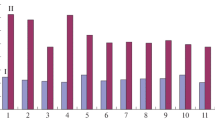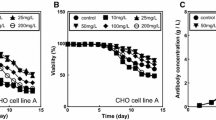Abstract
A balanced supplementation method was applied to develop a serum and protein- free medium supporting hybridoma cell batch culture. The aim was to improve systematically the initial formulation of the medium to prevent limitations due to unbalanced concentrations of vitamins and amino acids. In a first step, supplementation of the basal formulation with 13 amino acids, led to an increase of the specific IgA production rate from 0.60 to 1.07 pg cell−1 h−1. The specific growth rate remained unchanged, but the supplementation enabled maintenance of high cell viability during the stationary phase of batch cultures for some 70 h. Since IgA production was not growth- related, this resulted in an approximately4-fold increase in the final IgA concentration, from 26.6 to 100.2 mgl−1. In a second step, the liposoluble vitamins E and K3 were added to the medium formulation. Although this induced a slightly higher maximal cell concentration, it was followed by a sharp decline phase with the specific IgA production rate falling to 0.47 pg cell−1 h−1. However, by applying a second cycle of balanced supplementation with amino acids this decline phase could be reduced and a high cell viability maintained for over 300 h of culture. In this vitamin- and amino acid- supplemented medium, the specific IgA production rate reached a value of 1.10 pg cell−1h−1 with a final IgA concentration of 129.8 mgl−1. The latter represents an increase of approximately5-fold compared to the non- supplemented basal medium.
Similar content being viewed by others
References
Baker H., DeAngelis B. and Frank O. 1988. Vitamins and other metabolites in various sera commonly used for cell culturing. Experientia 44: 1007–1010.
Banik G.G. and Heath C.A. 1996. High-density hybridoma perfusion culture - limitation vs inhibition. Appl. Biochem. Biotechnol. 61: 211–229.
Barman H.K. and Rajput Y.S. 1993. Serum-free and serum-containing media for hybridoma culture. J. Sci. Industr. Res. 52: 803–807.
Barnes D. and Sato G. 1980. Methods for growth of cultured cells in serum-free medium. Anal. Biochem. 102: 255–270.
Chen Z., Ke Y. and Chen Y. 1993. A serum-free medium for hybridoma cell culture. Cytotechnology 11: 169–174.
Chua F., Oh S.K.W., Yap M. and Teo W.K. 1994. Enhanced IgG production in eRDF media with and without serum. Methods 167: 109–119.
Ducommun P., Bolzonella I., Rhiel M., Pugeaud P., Von Stockar U. and Marison I.W. 2001. On-line determination of animal cell concentration. Biotechnol. Bioeng. 72: 515–522.
Duval D., Demangel C., Munier-Jolain K., Miossec S. and Geahel I. 1991. Factors controlling cell proliferation and antibody production in mouse hybridoma cells: I. influence of the amino acid supply. Biotechnol. Bioeng. 38: 561–570.
Engström W. and Zetterberg A. 1984. The relationship between purines, pyrimidines, nucleosides, and glutamine for fibroblast cell proliferation. J. Cell. Physiol. 120: 233–241.
Evans V.J., Bryant J.C., Kerr H.A. and Schilling E.L. 1964. Chemically defined media for cultivation of long-term cell strains from four mammalian species. Exp. Cell. Res. 36: 439–474.
Geaugey V., Duvall D., Geahel I., Marc A. and Engasser J.M. 1989. Influence of amino acids on hybridoma cell viability and anti-body secretion. Cytotechnology 2: 119–129.
Hewlett G. 1991. Strategies for optimising serum-free media. Cytotechnology 5: 3–14.
Higushi K. 1973. Cultivation of animal cells in chemically defined media, a review. Adv. Appl. Microbiol. 16: 111–136.
Hiller G.W., Clark D.S. and Blanch H.W. 1994. Transient responses of hybridoma cells in continuous-culture to step changes in amino-acid and vitamin concentrations. Biotechnol. Bioeng. 44: 303–321.
Jo E.-C., Park H.-J., Park J.-M. and Kim K.-H. 1990. Balanced nutrient fortification enables high-density hybridoma cell culture in batch culture. Biotechnol. Bioeng. 36: 717–722.
Kurano S., Kurano N., Leist C. and Fiechter A. 1990. Utilization and stability of vitamins in serum-containing and serum-free media in CHO cell culture. Cytotechnology 4: 243–250.
Leist C.H., Meyer H.-P. and Fiechter A. 1990. Potential and problems of animal cells in suspension culture. J. Biotechnol. 15: 1–46.
Marquis C.P., Barford J.P., Harbour C. and Fletcher A. 1996a. Carbohydrate and amino acid metabolism during batch culture of a human lymphoblastoid cell line, BTSN6. Cytotechnology 21: 121–132.
Marquis C.P., Barford J.P. and Harbour C. 1996b. Amino acid metabolism during batch culture of a murine hybridoma, AFP-27. Cytotechnology 21: 111–120.
Renard J.M., Spagnoli R., Mazier C., Salles M.F. and Mandine E. 1988. Evidence that antibody production kinetics is related to the integral of the viable cells curve in batch systems. Biotechnol. Lett. 10: 91–96.
Reuveny S., Velez D., Macmillan J.D. and Miller L. 1986. Factors affecting cell growth and monoclonal antibody production in stirred reactors. J. Immunol. Methods 86: 53–59.
Shacter E. 1989. Serum-free media for bulk culture of hybridoma cell and the preparation of monoclonal antibodies. TIBTECH 7: 248–253.
Simpson N.H., Singh R.P., Perani A., Goldenzon C. and Al-Rubeai M. 1998. In hybridoma cultures, deprivation of any single amino acid leads to apoptotic death, which is suppressed by the expression of the bcl-2 gene. Biotechnol. Bioeng. 59: 90–98.
Stoll T.S., Mühlethaler K., von Stockar U. and Marison I.W. 1996. Systematic improvement of a chemically-defined protein-free medium for hybridoma growth and monoclonal antibody production. J. Biotechnol. 45: 111–123.
Xie L.Z. and Wang D.I.C. 1994. Stoichiometric analysis of animal cell growth and its application in medium design. Biotechnol. Bioeng. 43: 1164–1174.
Zetterberg A. and Engström W. 1981. Glutamine and the regulation of DNA replication and cell multiplication in fibroblasts. J. Cell. Physiol. 108: 365–373.
Author information
Authors and Affiliations
Rights and permissions
About this article
Cite this article
Ducommun, P., Ruffieux, PA., von Stockar, U. et al. The role of vitamins and amino acids on hybridoma growth and monoclonal antibody production. Cytotechnology 37, 65–73 (2001). https://doi.org/10.1023/A:1019956013627
Issue Date:
DOI: https://doi.org/10.1023/A:1019956013627




